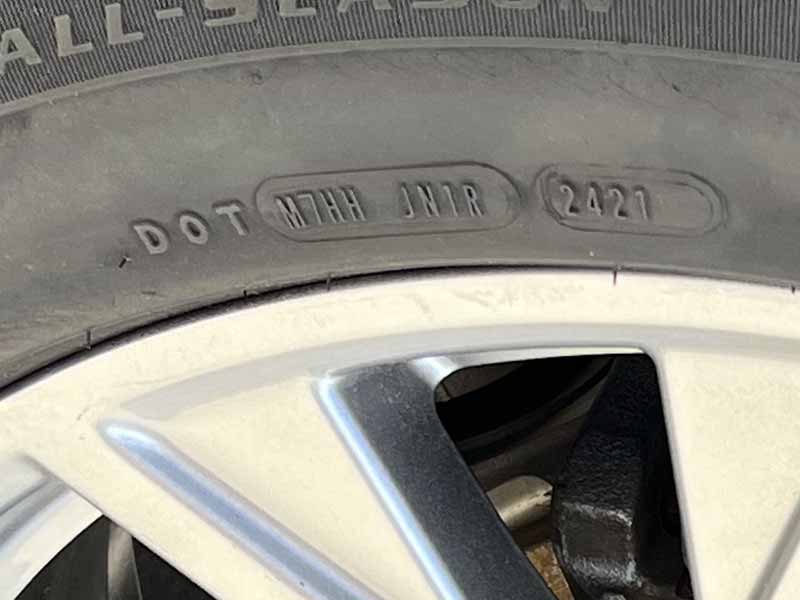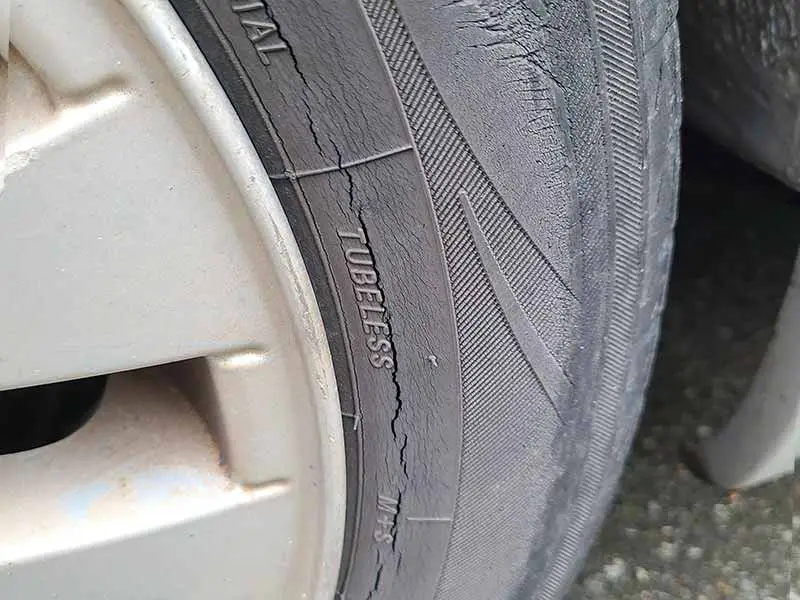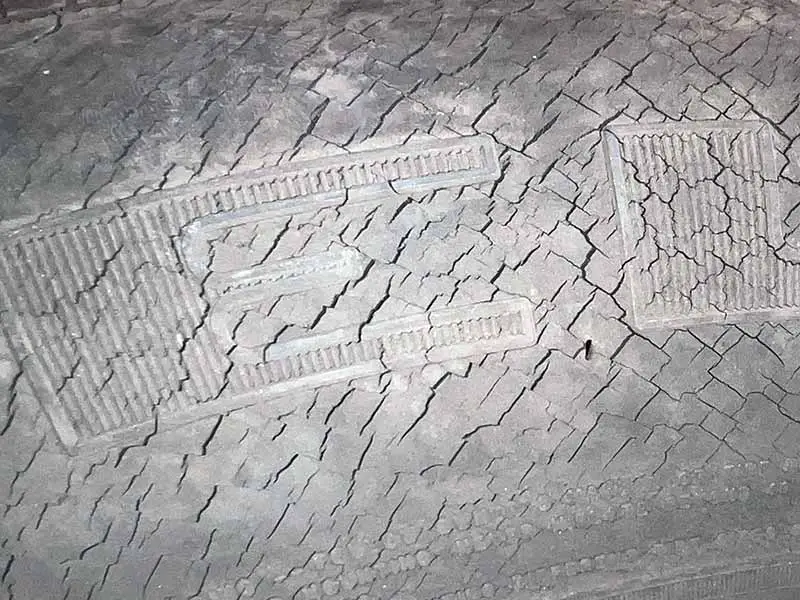An estimated 33% of vehicles on US roads have at least one tire with dry rot. That’s a big deal, as dry rot can make your tires more prone to blowouts and accidents.
When To Replace Tires With Dry Rot
Tires with dry rot should be replaced before the cracks reach 1/16″ in depth. Other issues, such as deep cracks or loss of grip, may require replacing them even earlier.
Generally, tires have a lifespan of about six years, but proper storage, regular maintenance, and frequent usage can help prevent dry rot and prolong their life.
In this article, we’ll take you through the ins and outs of dry rot, from spotting the danger signs to knowing when it’s time to say goodbye to your old tires.
By the end, you’ll not only be an expert in identifying dry rot but also learn how to stop it from happening in the first place.
Let’s take a closer look.
When Is Dry Rot On Tires Dangerous?
Dry rot on tires can be a sneaky problem, and it’s important to know when it starts getting dangerous. As an expert on tires, let’s break it down into simpler terms. Dry rot occurs when the rubber in your tires starts to break down and lose its flexibility. This can lead to cracks, leaks, or even blowouts if left unchecked. But don’t panic! We’ll help you figure out when you should be worried and when it’s time to replace those tires.
First, let’s talk about the effects of dry rot on tire performance. When your tires start to dry rot, they lose their ability to grip the road properly. This can make it more challenging to control your car, especially in wet or slippery conditions. If you’re noticing that your car isn’t handling as well as it used to, it might be time to take a closer look at your tires.
Now, let’s talk about the risks of driving on dry rotted tires. As the rubber breaks down, it becomes more brittle and can crack or split more easily. This can lead to a sudden loss of air pressure, also known as a blowout, which can be very dangerous, especially if you’re driving at high speeds. A blowout can cause you to lose control of your vehicle, potentially leading to accidents.
So, when should you start worrying about dry rot on your tires? Here are a few factors to consider:
- The Depth Of The Cracks: If you see small, surface-level cracks on your tires, it might not be a big deal. However, if the cracks are deep enough to reach the tire’s cords (the internal structure), it’s time to replace those tires.
- The Age Of Your Tires: Tires usually have a lifespan of about six years, but this can vary depending on how well you take care of them. If your tires are older than six years, it’s a good idea to inspect them regularly for signs of dry rot.
- The Amount Of Use: Tires that are used more often are less likely to develop dry rot. If your car is sitting for extended periods, be sure to inspect your tires for dry rot before hitting the road again.
- The Severity Of The Issue: If you’re experiencing any of the dangerous effects mentioned earlier (loss of grip, unusual vibrations, or noises), it’s time to replace your tires.

Sidewall Cracking Chart
Understanding the condition of your tires is crucial for your safety on the road, and that’s where a sidewall cracking chart comes in handy. I’ll explain what a sidewall cracking chart is, how to use it, and how it can help you decide when to replace your tires.
A sidewall cracking chart is a visual guide that helps you determine the severity of cracks on the sidewalls of your tires. The chart usually consists of a series of images or diagrams, each showing different levels of cracking. The images range from no cracking (which means your tires are in good shape) to severe cracking (which indicates that it’s time for new tires).
Here’s how you can use a sidewall cracking chart to check your tires:
- Park your car on a flat surface, making sure it’s safe and secure. Turn off the engine and engage the parking brake.
- Inspect the sidewalls of each tire. Look for any cracks or signs of dry rot. If you see any cracks, compare them to the images on the sidewall cracking chart.
- Determine the severity of the cracking by comparing the cracks on your tires to the images on the chart. If the cracks on your tires look like the images with mild or no cracking, your tires are likely still safe to use.
- If the cracks on your tires resemble the images with moderate or severe cracking, it’s time to start thinking about replacing your tires. Driving with severely cracked tires can be dangerous, as they may lead to a blowout or loss of control while driving.
- Remember that a sidewall cracking chart is just a helpful tool, not an absolute rule. If you’re unsure about the condition of your tires or if you think they might be unsafe, consult a professional tire technician for an expert opinion.
Level One Dry Rot

Level Two Dry Rot

Level Three Dry Rot

Level Four Dry Rot

Level Five Dry Rot

How Long Before Tires Dry Rot
The truth is, there’s no one-size-fits-all answer to this question. Various factors can influence the aging process of tires. Let’s dive into the factors that affect tire aging and the average lifespan of tires, so you can stay informed and keep your vehicle running safely.
Factors Affecting Tire Aging
- Storage Conditions: Tires that are stored in a cool, dry, and dark place tend to age more slowly than those exposed to direct sunlight, extreme temperatures, or moisture. Proper storage can significantly extend the life of your tires.
- Usage: Tires that are used regularly are less likely to dry rot compared to those that sit unused for extended periods. Regular use helps maintain the flexibility of the rubber, preventing it from becoming brittle.
- Maintenance: Well-maintained tires, such as those with proper inflation and regular rotation, are less likely to develop dry rot. Good maintenance practices can help prolong the life of your tires.
- Tire Quality: Higher-quality tires made from premium materials tend to be more resistant to dry rot than cheaper, lower-quality options.
Average Lifespan Of Tires
Generally speaking, the average lifespan of tires is around six years. However, this number can vary depending on the factors mentioned above, as well as the specific tire brand and model. Some tires may last up to 10 years, while others may start to show signs of dry rot in as little as three years.

Signs Of Dry Rot
By catching early warning signs of dry rot, you can take action to slow down the damage before you need to replace your tires. Let’s take a look at some of the most common signs of dry rot so you can keep an eye out and keep your vehicle running safely.
- Visible Cracks: One of the most obvious signs of dry rot is the appearance of cracks on your tires. These cracks can be found on the tread, sidewalls, or even between the tread blocks. If you notice any cracks, especially deep ones that expose the tire cords, it’s time to replace your tires.
- Tire Discoloration: As the rubber in your tires begins to break down, it can cause the tires to change color. If you notice that your tires are turning a dull gray or brownish color instead of their usual shiny black, it could be a sign of dry rot.
- Bulges Or Deformations: Dry rot can cause the internal structure of your tires to weaken, leading to bulges or deformations in the tire’s shape. If you see any unusual bumps or irregularities on the surface of your tires, it could be a sign of dry rot and an indication that you need new tires.
- Unusual Vibrations Or Noises While Driving: If your tires are experiencing dry rot, they may not perform as well as they should, causing unusual vibrations or noises while you’re driving. This could be a sign that the tire’s internal structure has been compromised, and it’s time for a replacement.

My Favorite UV Protectant For Protecting Tires From UV Damage
How To Stop Dry Rot On Tires
Preventing dry rot is key to keeping your tires in top shape and ensuring your safety on the road. While it’s impossible to completely stop the aging process of tires, there are several steps you can take to slow it down and reduce the risk of dry rot. Let’s explore some of the best practices for stopping dry rot on your tires.
- Proper Storage Conditions: When your car is not in use, or if you’re storing spare tires, make sure to keep them in a cool, dry, and dark place. Exposure to direct sunlight, extreme temperatures, and moisture can speed up the aging process and increase the risk of dry rot.
- Regular Tire Maintenance: Make it a habit to check your tires regularly for signs of dry rot, such as cracks, discoloration, or deformations. Properly maintaining your tires, including keeping them inflated to the correct pressure and rotating them as recommended by the manufacturer, can help prolong their life and prevent dry rot.
- Importance Of Tire Rotation: Rotating your tires every 5,000 miles (or as recommended by your vehicle’s manufacturer) helps ensure even wear and prevents the rubber from becoming brittle in one spot. This can reduce the likelihood of dry rot developing.
- Using Tire Protectants: Some tire protectants on the market can help slow down the aging process by providing a barrier against harmful UV rays and other environmental factors. Look for protectants specifically designed for tires, and follow the manufacturer’s instructions for application.
Keep in mind that these steps can help slow down the aging process and reduce the risk of dry rot, but they can’t stop it entirely. It’s essential to regularly inspect your tires and replace them when necessary to ensure your safety on the road.
Resources
Below are some links you may find helpful when learning about tires
Final Thoughts
We’ve explored the signs of dry rot, how to prevent it, and when it’s time to take action.
As the famous tire expert, Harvey Firestone once said, “The tire is the one thing between the vehicle and the road.” So, by taking care of your tires and addressing dry rot issues, you’re not only keeping yourself safe but also contributing to the overall safety of everyone on the road.
Remember, regular inspections and proper tire maintenance can go a long way in preventing dry rot and prolonging the life of your tires.
Good luck and happy motoring.




